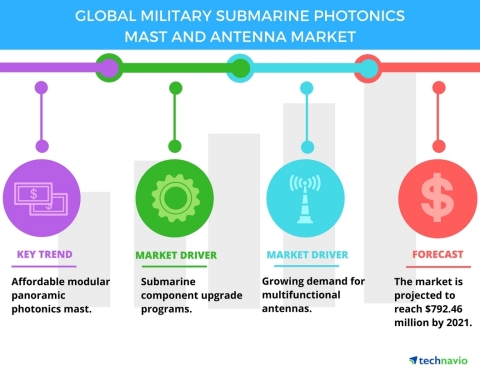LONDON--(BUSINESS WIRE)--Technavio’s latest report on the global military submarine photonics mast and antenna market provides an analysis of the most important trends expected to impact the market outlook from 2017-2021. Technavio defines an emerging trend as a factor that has the potential to significantly impact the market and contribute to its growth or decline.
The photonics mast and antenna market will grow during the forecast period owing to the globally changing military scenario. These components are typically deployed on submarines and are positively correlated with the dynamics of the submarine market. These components have undergone significant design changes to support enhanced stealth capabilities. Such design changes and operational shortcomings in traditional periscopes have resulted in the development of photonics masts. These are highly sophisticated and demand a high level of technical know-how from manufacturers, thus limiting their number in the market.
This report is available at a USD 1,000 discount for a limited time only: View market snapshot before purchasing
Buy 1 Technavio report and get the second for 50% off. Buy 2 Technavio reports and get the third for free.
The top three emerging trends driving the global military submarine photonics mast and antenna market according to Technavio aerospace and defense research analysts are:
- Affordable modular panoramic photonics mast
- Adoption of SWIR for photonics mast
- Emergence of non-hull penetrating masts
Looking for more information on this market? Request a free sample report
Technavio’s sample reports are free of charge and contain multiple sections of the report including the market size and forecast, drivers, challenges, trends, and more.
Affordable modular panoramic photonics mast
“Affordable modular panoramic photonics mast is a product of Panavision Federal Systems, a company based in California. The AMPPM sensor mast provides a 360° panoramic search capabilities to the submarine through many visible and IR sensors. It is also equipped with SWIR and hyperspectral sensors for long-range detection and identification,” says Moutushi Saha, a lead analyst at Technavio for research on defense.
AMPPM has a modular and non-rotational design that allows a reduction in fabrication and maintenance costs owing to the reduced wear as compared with the current rotating mast. Also, the modular structure allows more maintenance to be done at the intermediate-level (vs. the depot level). The mast uses Spinel-based materials for all IR and visible windows and offers enhanced durability, improved transparency, and reduced weight.
Adoption of SWIR for photonics mast
“Submarines often need to capture high-quality images even in the particulate environment. Therefore, SWIR systems are increasingly being deployed in photonics masts owing to their superior imaging capabilities. As the longer wavelengths of SWIR systems can easily penetrate through such environments, they are more efficient than the visible imagers,” adds Moutushi.
SWIR systems utilize the light reflected from objects as the principle of imaging as opposed to MWIR and long wave infrared (LWIR) systems. The MWIR and LWIR systems tend to use thermal imaging techniques that provide high resolution in short wavelengths only. In such cases, SWIR systems can be used as complementary sensors to obtain greater resolution and to track human targets using long-range optics. This growing use of SWR will boost the growth of the global military submarine photonics mast and antenna market during the forecast period.
Emergence of non-hull penetrating masts
The major advantage of using photonics mast is that, unlike periscopes, it does not penetrate the hull of a submarine. The traditional periscopes may be visible when they rise, thereby creating risks of detection. The photonics mast, however, rises above the water surface in telescopic motion and penetrates only the sail. This eliminates the need for a large opening in the hull and also limits the risk of water leakage in the event of damage. The structural stability of the submarine is also improved.
Conventional periscopes required the control room to be in a constrained upper deck. Photonics masts, however, allow greater design freedom. For instance, the cabling requirements of masts can be met by a tiny hull opening, and the mast can be fitted entirely in the submarine's sail. Thus, the control room need not be located directly below the sail.
Browse Related Reports:
- Global Military Night Vision Device Market 2017-2021
- Global Armored Vehicles Automatic Fire Extinguishing Systems (AFES) Market 2017-2021
- Global Military Augmented Reality (AR) Headgear Market 2017-2021
About Technavio
Technavio is a leading global technology research and advisory company. Their research and analysis focuses on emerging market trends and provides actionable insights to help businesses identify market opportunities and develop effective strategies to optimize their market positions.
With over 500 specialized analysts, Technavio’s report library consists of more than 10,000 reports and counting, covering 800 technologies, spanning across 50 countries. Their client base consists of enterprises of all sizes, including more than 100 Fortune 500 companies. This growing client base relies on Technavio’s comprehensive coverage, extensive research, and actionable market insights to identify opportunities in existing and potential markets and assess their competitive positions within changing market scenarios.
If you are interested in more information, please contact our media team at media@technavio.com.




